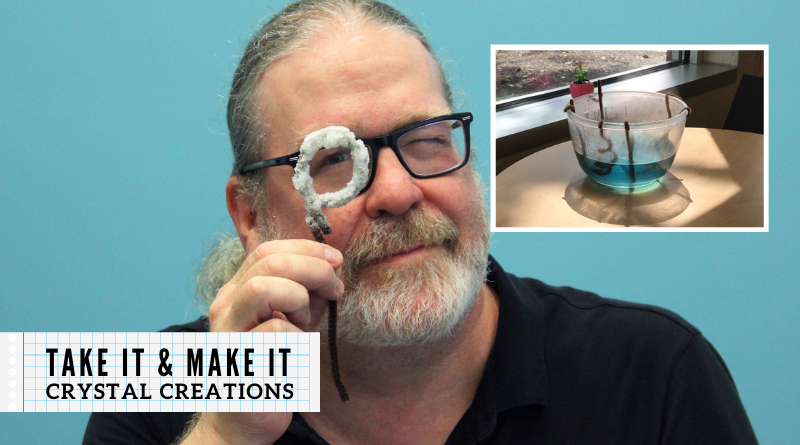
STEAM Connections: Crystal Creations
What do salt, snowflakes, and quartz all have in common? – They’re all crystals! Don’t believe me? Let’s take a closer look at what makes a crystal, and how we may be able to make our own at home.
Content Overview
Crystals are solids that are formed when molecules are connected together in regular and repeating patterns. Most crystals come in geometric shapes with sharp, straight edges and smooth sides, called facets. Because the atoms lock together in such an orderly fashion, the resulting crystals take the shape of the molecules that form them. Salt crystals have a cubic shape while sugar crystals have a flattened rectangular shape.
Snow is made from solidified water molecules, H2O, which reliably form each unique snowflake with exactly six sides.
The process of crystals forming is called crystallization. Crystallization occurs in nature when liquid cools and starts to harden, like magma cooling into a mineral quartz crystal, or when water evaporates from a mixture – this is where sea salt comes from.
Hands-On Exploration
Let’s see how we can use some common materials to grow our own crystals.
Supplies

- 4 cups boiling water
- 2 cups Borax
- 5 – 8 pipe cleaners
- Large heat-safe glass container
- Scissors (if needed to cut down pipe cleaners)
Instructions
1. Prepare pipe cleaners – Bend pipe cleaners into the shape you want your crystals to grow. If you want to make a geode, spiral several pipe cleaners into a hollow rock shapes. Think of it as the skeleton of a geode.
2. Prepare Borax solution – Bring water to a boil, dissolve borax into water. Keep adding borax until it stops dissolving in the water (this is when solubility is occurring). You can add food coloring to the mixture if you want the crystals to have some color. Set aside to cool.
3. Pour mixture in container – Pour you mixture into a container that is slightly larger than you pipe cleaner structure.
4. Leave in safe place – Leave the containers undisturbed in a safe place, like next to a sunny window. A warm spot will slow down the cooling process, allowing better crystals to form.
5. Observe and record – After a couple of hours, check your structure and dislodge it from the container. At this point, there should be some crystals covering your pipe cleaner.
Talk About the Activity
What happened to the pipe cleaner as it sat in the borax solution over time? If you want more crystals or your object is not covered yet, repeat the process. New crystals will grow on top of the current ones.
When we dissolve borax crystals in water we create a mixture. Saturation refers to the maximum amount of a substance that can be dissolved into another substance under normal circumstances. Adding heat increases the solubility, which is the ability of the borax to dissolve in the water. So what does this mean?
It means that the water is super-saturated with borax crystals. The heat causes the water molecules to move farther away from each other so that they can actually hold more borax than they would normally be able to.
As it cools, the water molecules come closer together again and the extra borax in the mixture can no longer be contained by the colder water. That is when the borax falls out of the mixture and clings to the pipe cleaner, and reforms into crystals. This is called recrystallization.
What do you notice about the shape of the new crystals?
Continued Learning

Salt, sugar, and Epsom salts are all examples of crystals. Conduct your own science experiment and create different types of crystals. Observe how the crystals are different and how they are the same. You can use the library catalog to search for books using terms such as “crystals”, “gems”, and “crystalization” – be sure to use the filters on the left toolbar to look in the non-fiction sections. Here are some books from the library collection where you can learn more about crystals:
All About Crystals and Gems: Discovering Treasures of the Natural World by Libby Romero
Crystals by Patrick Perish
Kitchen Chemistry: Cool Crystals, Rockin’ Reactions, and Magical Mixtures by Cynthia Brown
My Book of Rocks and Minerals by Devin Dennis




